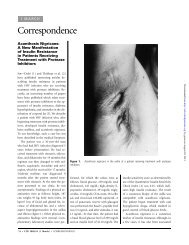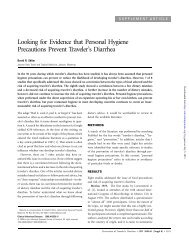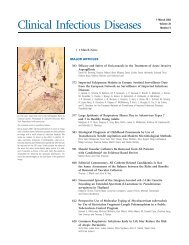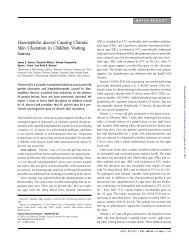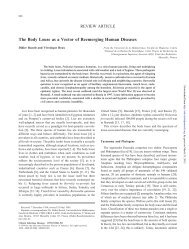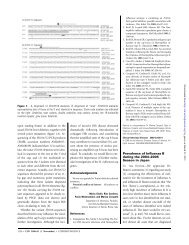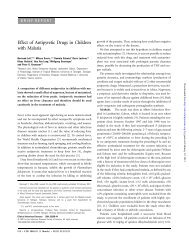Klebsiella pneumoniae - Clinical Infectious Diseases
Klebsiella pneumoniae - Clinical Infectious Diseases
Klebsiella pneumoniae - Clinical Infectious Diseases
Create successful ePaper yourself
Turn your PDF publications into a flip-book with our unique Google optimized e-Paper software.
Table 8. Distribution of 20-kb kfu/PTS region, rmpA copy number, and indicators of virulence among strains of different<br />
genotypes.<br />
Factor<br />
292 • CID 2007:45 (1 August) • Fang et al.<br />
K1<br />
(n p 100)<br />
K2<br />
(n p 36)<br />
K20<br />
(n p 6)<br />
Genotype<br />
K5<br />
(n p 7)<br />
K54<br />
(n p 8)<br />
K57<br />
(n p 5)<br />
Other<br />
(n p 15)<br />
20-kb kfu/PTS region 97 (97) 0 (0) 3 (50) 4 (57) 0 (0) 0 (0) 6 (40)<br />
Mean no. of rmpA copies per strain 2.1 1.9 2.0 1.7 1.8 2.0 1.5<br />
Hypermucoviscosity 95 (95) 35 (97) 4 (67) 7 (100) 7 (88) 5 (100) 11 (73)<br />
Serum resistance (graded by 1-h survival ratio)<br />
Highly resistant (13.0) 89 (89) 21 (58) 3 (50) 3 (43) 2 (25) 0 (0) 0 (0)<br />
Resistant (0.9–3.0) 9 (9) 10 (28) 1 (17) 2 (29) 5 (63) 0 (0) 5 (33)<br />
Susceptible (0.1–0.9) 1 (1) 2 (6) 0 (0) 1 (14) 1 (13) 4 (80) 8 (53)<br />
Highly susceptible (!0.1) 1 (1) 3 (8) 2 (33) 1 (14) 0 (0) 1 (20) 2 (13)<br />
Group median 7.5 3.2 5.3 1.4 1.8 0.2 0.3<br />
NOTE. Data are no. (%) of strains, unless otherwise indicated.<br />
suggest that K1 and K2 strains should be treated separately in<br />
future research.<br />
Studies from �10 years ago reported 10%–11% mortality<br />
in patients with K. <strong>pneumoniae</strong> pyogenic liver abscess who were<br />
treated with drainage of pus and administration of cefazolin<br />
plus gentamicin [16]. In the present study, physicians administered<br />
pus drainage and more potent third-generation cephalosporins<br />
[52] to nearly all patients and achieved a mortality<br />
rate of 2.8% (0% in nondiabetic patients). This low mortality<br />
is similar to that of 2 recent reports from the United States<br />
[50, 53]. Thus, the main concern is no longer mortality, but<br />
catastrophic disability due to irreversible ocular or neurological<br />
complications. The advance in the cps genotyping method,<br />
based on PCR detection of magA (wzy_K1), provides an accurate,<br />
rapid, and convenient molecular diagnosis for highly<br />
pathogenic K1 strains. This procedure is simple and inexpensive<br />
and can be easily replicated in general clinical microbiology<br />
laboratories. Although K1 strains can also be identified by capsular<br />
K serotyping using countercurrent immunoelectrophoresis,<br />
this procedure is relatively complex, requires expensive<br />
high-quality antisera, and is available only in a few reference<br />
laboratories worldwide [29, 54].<br />
There has been considerable attention given to the increasing<br />
frequency of K. <strong>pneumoniae</strong> isolated from pyogenic liver abscess<br />
over the past 3 decades in Taiwan and other geographic areas<br />
[50–53]. The present study shows that K. <strong>pneumoniae</strong> genotype<br />
K1 is an emerging pathogen capable of causing catastrophic<br />
septic ocular or CNS complications from pyogenic liver abscess<br />
independent of host underlying diseases. Our results highlight<br />
the need to further investigate the epidemiology of this virulent<br />
organism.<br />
Acknowledgments<br />
Financial support. National Taiwan University Hospital (NTUH-92-<br />
021, NTUH-93-S002, NTUH-94-A20, NTUH-95-A07, and NTUH-96-<br />
A26); National Science Council (NSC-91-2314-B-002-178, NSC-92-2314-<br />
B-002-114, NSC-93-2314-B-002-071, and NSC-95-2314-B-002-247-MY3).<br />
Potential conflicts of interest. All authors: no conflicts.<br />
References<br />
1. Podschun R, Ullmann U. <strong>Klebsiella</strong> spp. as nosocomial pathogen: epidemiology,<br />
taxonomy, typing methods, and pathogenicity factors. Clin<br />
Microbiol Rev 1998; 11:589–603.<br />
2. Casanova C, Lorente JA, Carrillo F, Rodriguez EP, Nunez N. <strong>Klebsiella</strong><br />
<strong>pneumoniae</strong> liver abscess associated with septic endophthalmitis [letter].<br />
Arch Intern Med 1989; 149:1467.<br />
3. Cheng DL, Liu YC, Yen MY, Liu CY, Wang RS. Septic metastatic lesions<br />
of pyogenic liver abscess: association with <strong>Klebsiella</strong> <strong>pneumoniae</strong> bacteremia<br />
in diabetic patients. Arch Intern Med 1991; 151:1557–9.<br />
4. Chou FF, Kou HK. Endogenous endophthalmitis associated with pyogenic<br />
hepatic abscess. J Am Coll Surg 1996; 182:33–6.<br />
5. Cahill M, Chang B, Murray A. Bilateral endogenous bacterial endophthalmitis<br />
associated with pyogenic hepatic abscess [letter]. Br J<br />
Ophthalmol 2000; 84:1436.<br />
6. Ohmori S, Shiraki K, Ito K, et al. Septic endophthalmitis and meningitis<br />
associated with <strong>Klebsiella</strong> <strong>pneumoniae</strong> liver abscess. Hepatol Res<br />
2002; 22:307–12.<br />
7. Saccente M. <strong>Klebsiella</strong> <strong>pneumoniae</strong> liver abscess, endophthalmitis, and<br />
meningitis in a man with newly recognized diabetes mellitus. Clin<br />
Infect Dis 1999; 29:1570–1.<br />
8. Yoon YH, Lee SU, Sohn JH, Lee SE. Result of early vitrectomy for<br />
endogenous <strong>Klebsiella</strong> <strong>pneumoniae</strong> endophthalmitis. Retina 2003; 23:<br />
366–70.<br />
9. Fang CT, Chen YC, Chang SC, Shau WY, Luh KT. <strong>Klebsiella</strong> <strong>pneumoniae</strong><br />
meningitis: timing of antimicrobial therapy and prognosis. QJM<br />
2000; 93:45–53.<br />
10. Fung CP, Chang FY, Lee SC, et al. A global emerging disease of <strong>Klebsiella</strong><br />
<strong>pneumoniae</strong> liver abscess: is serotype K1 an important factor for complicated<br />
endophthalmitis? Gut 2002; 50:420–4.<br />
11. Lin JC, Chang FY, Fung CP, et al. High prevalence of phagocyticresistant<br />
capsular serotypes of <strong>Klebsiella</strong> <strong>pneumoniae</strong> in liver abscess.<br />
Microbes Infect 2004; 6:1191–8.<br />
12. Lin JC, Siu LK, Fung CP, et al. Impaired phagocytosis of capsular<br />
serotypes K1 or K2 <strong>Klebsiella</strong> <strong>pneumoniae</strong> in type 2 diabetes mellitus<br />
patients with poor glycemic control. J Clin Endocrinol Metab 2006;<br />
91:3084–7.<br />
13. Yeh KM, Kurup A, Siu LK, et al. Capsular serotype K1 or K2, rather<br />
than magA and rmpA, is a major virulence determinant for <strong>Klebsiella</strong><br />
Downloaded from<br />
http://cid.oxfordjournals.org/ by guest on December 7, 2012



